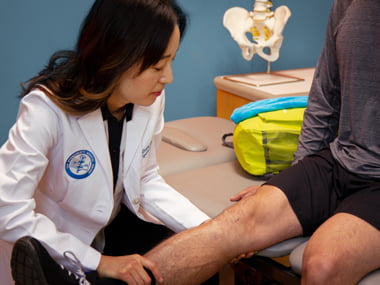Kaiser Permanente’s Sports Medicine Program is an extension of the Thrive brand that supports active people of all ages and abilities in doing what they love.


Catherine Dubay is a lifelong runner who reluctantly fell in love with the sport as a teenager, when she did not make her high-school volleyball team. She ran competitively in high school and then at the collegiate level. Today she is an active member of a cross-country club team in Santa Rosa.
Last year, though, Dubay was sidelined with a debilitating hip injury.
“I had been injury free for many, many years and was able to maintain a high level of training,” she said. “I was beginning to find a new love of senior running and was headed to a West Coast senior championship, hoping to win. The hip injury definitely wasn’t in my plan.
Dubay is not your typical everyday athlete, but her situation does illustrate a growing trend in which more people, both athletic and active, are seeking medical care related to sports or musculoskeletal injuries. In fact, sports injuries have become the second most common reason for visits to a doctor’s office nationwide, behind only the common cold, according to a survey by National Ambulatory Medical Care.
Within Kaiser Permanente Northern California in 2016, patients averaged approximately 4,500 office visits per month for sports medicine-related conditions, and orthopedic surgeons performed more than 47,000 sports medicine surgeries.
Sports medicine physicians, both orthopedic surgeons and medical, have been part of The Permanente Medical Group’s integrated and multidisciplinary model for many years, working as a team to treat sports-related injuries for amateur and professional athletes, as well as for individuals who experience more common injuries that come from sports or other activities.
Today, TPMG has more than 50 board-certified, fellowship-trained sports medicine physicians who specialize in orthopedic surgery, physical medicine and rehabilitation, family medicine, pediatrics, and emergency medicine, making it one of the largest and most comprehensive sports medicine practices in the country.
“The care we deliver rivals the best in sports medicine,” said Todd Weitzenberg, MD, regional co-lead for sports medicine and a physical medicine and rehabilitation physician at the KP Santa Rosa Medical Center. “Our integrated and coordinated approach — with sports medicine care, orthopedics, physical therapy, medical imaging, and ancillary support all under one roof — is a real advantage for our patients, both in terms of clinical outcomes and convenience.”
Positioning Sports Medicine
With the significant increase in demand for sports medicine care by younger patients, coupled with the resultant need for more musculoskeletal physical therapy, there is a new focus on positioning sports medicine within KP medical centers.
James Chang, MD, TPMG associate executive director, who is leading this redesign effort, wants to reshape the perception within KP membership and communities about sports medicine.
“What we have learned is that many KP Northern California members are not aware that we offer sports medicine as a specialty. But that is changing as a result of the significant internal support for the sports medicine, as well as TPMG’s clinical affiliation with professional sports organizations such as the San Jose Sharks and the Sacramento Kings.”
Our biggest push right now is physical therapy space,” said Mark Davies, MD, orthopedic surgeon at KP San Jose, regional sports medicine co-lead, and team、physician for the San Jose Sharks. “As we grow membership, and with the demand for sports physical therapy also on the rise, we are working closely with Rehabilitation Services and National Facilities Services and have assembled a group of physical therapists, physicians, and staff to collectively explore how the 21st- century physical therapy gyms should be designed.”
Dr. Weitzenberg said Kaiser Permanente’s integrated model is ideal for sports medicine, as demonstrated by the care Dubay received.
“Our physicians are connected to our physical therapists, and as a result we offer a different level of care. Ms. Dubay’s hip injury, for example, was quickly addressed by a therapist and a board-certified and fellowship-trained sports medicine physician, who provided her with a sport-specific treatment plan and approach that made a dramatic difference in her recovery.”
Dubay agreed, saying that the care she received was “a game-changer for me. It has made a dramatic difference in my life and allowed me to get back to what I enjoy doing.”



